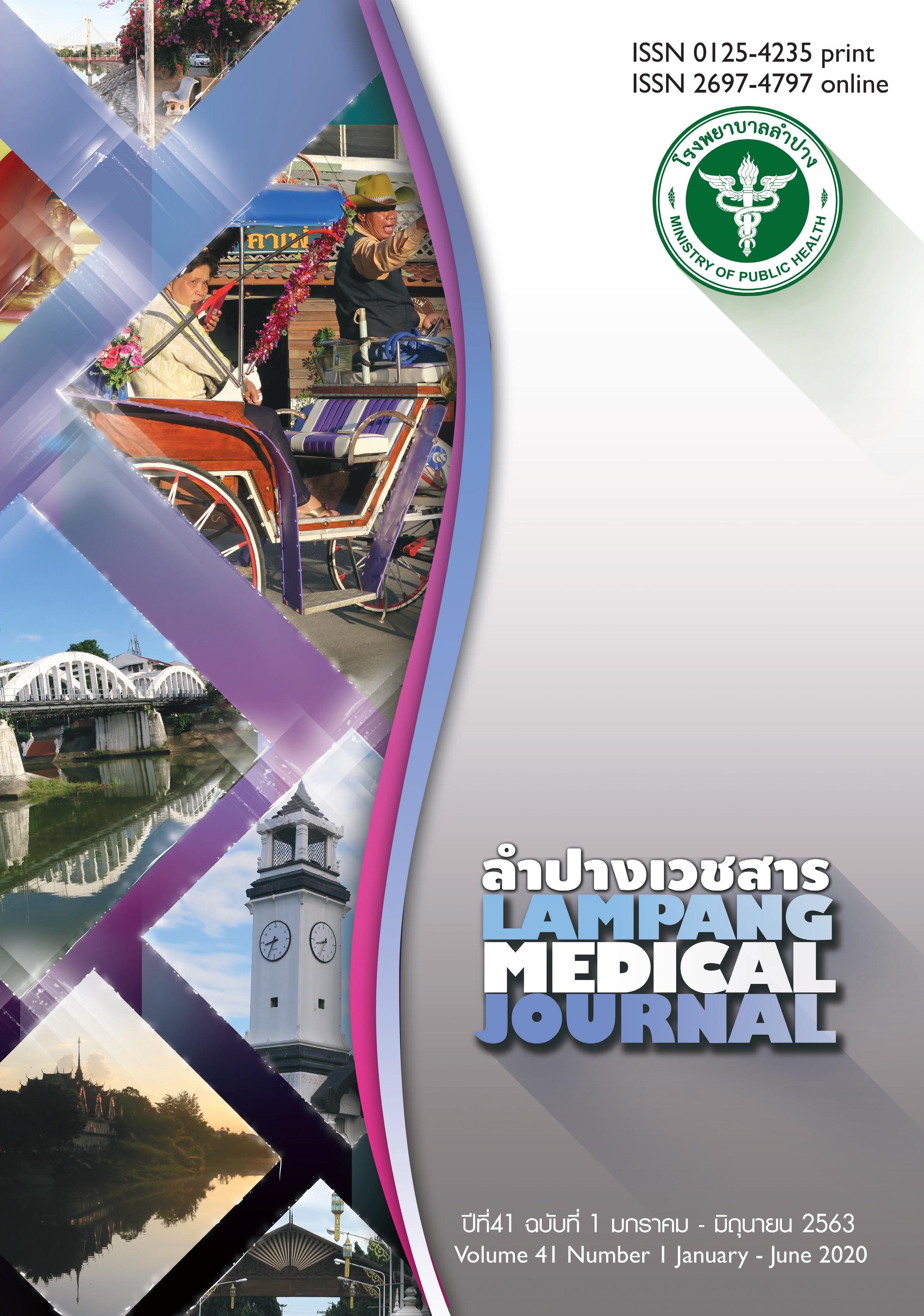Magnification of Digital Hip Radiographs in Hip Arthroplasties: a Study in the Real Practice
Main Article Content
Abstract
Background: Preoperative templating of total hip arthroplasty (THA) by placing a plastic template over the digital radiograph on a computer screen has high accuracy in size estimations. Some researchers have found that most radiographs have relatively constant magnifications of 15% or 20%, and templating with these constant magnifying factors without calibration may be acceptable in the real practice.
Objective: To determine the magnification of digital hip radiographs of Thai patients and comparing with the acceptable range for the estimation of the acetabular cup size (±4% or 2 mm)
Materials and methods: A retrospective-analytical study was conducted among hip radiographs of 119 patients who underwent unilateral THAs at Lampang Hospital from May 2015 to July 2019. We measured the diameter of femoral head prostheses in the PACS program and compared with the actual sizes from the medical records to calculate the magnification. The percentages of radiographs with magnification in the range of 15±4% and 20±4% were analyzed. The clinical data was compared between the two magnification groups, within versus outside the range. Logistic regression analysis was utilized to identify the factors that influenced the magnification.
Results: The mean age was 58.6±12.2 years; 51.3% were female; and the mean body mass index (BMI) was 22.3±3.9 kg/m2. The average magnification was 14.1±4.1%. There were 115 radiographic images (57.8%) with magnification in the range of 15±4%; and 82 images (41.2%) with magnification in the range
of 20±4%. No differences in age, gender, BMI were found between groups with magnification within or outside the range of 15±4% (p=0.848, 0.347 and 0.158, respectively). The magnification group in the range of 20 ± 4 % was older than the magnification group of <16% (60.5±11.6 vs 56.0±12.6 years, p=0.009). Age was a factor that affect the magnification for being within or outside the range of 20±4% (OR 0.97, 95%CI 0.95-0.99, p=0.022).
Conclusion: The digital hip radiographs had an average magnification of 14%. Three-fifths of the radiographs had a magnification in the range of 15±4 %, and only two-fifths had a magnification in the range of 20±4%. Hip radiograph should be calibrated with known-diameter metal marker before templating
on the computer-screen images. Otherwise, templates with 15% magnification could be used and more appropriately than the 20% magnifying templates.
Article Details
บทความที่ส่งมาลงพิมพ์ต้องไม่เคยพิมพ์หรือกำลังได้รับการพิจารณาตีพิมพ์ในวารสารอื่น เนื้อหาในบทความต้องเป็นผลงานของผู้นิพนธ์เอง ไม่ได้ลอกเลียนหรือตัดทอนจากบทความอื่น โดยไม่ได้รับอนุญาตหรือไม่ได้อ้างอิงอย่างเหมาะสม การแก้ไขหรือให้ข้อมูลเพิ่มเติมแก่กองบรรณาธิการ จะต้องเสร็จสิ้นเป็นที่เรียบร้อยก่อนจะได้รับพิจารณาตีพิมพ์ และบทความที่ตีพิมพ์แล้วเป็นสมบัติ ของลำปางเวชสาร
References
Kosashvili Y, Shasha N, Olschewski E, Safir O, Larry W, Gross A. Digital versus conventional templating techniques in preoperative planning for total hip arthroplasty. Can J Surg. 2009;52(1):6-11.
Petretta R, Strelzow J, Ohly NE, Misur P, Masri BA. Acetate templating on digital images is more accurate than computer-based templating for total hip arthroplasty. Clin Orthop Relat Res. 2015;473:3752–9.
Shin JK, Son SM, Kim TW, Shin JK, Son SM, Kim TW. Accuracy and reliability of preoperative onscreen
templating using digital radiographs for total hip arthroplasty. Hip Pelvis. 2016;28(4):201-7.
Brew CJ, Simpson MP, Whitehouse SL, Donnelly W, Crawford RW, Hubble MJW, F. Scaling digital radiographs for templating in total hip arthroplasty using conventional acetate templates independent of calibration markers. J
Arthroplasty. 2012;27(4):643-7.
Franken M, Grimm B, Heyligers I. A comparison of four systems for calibration when templating for total hip replacement with digital radiography. J Bone joint surgery(Br). 2010; 92(1)136-41.
Archibeck MJ, Cummins T, Tripuraneni KR, Carothers JT, Murray-Krezan C, Hattab M, et al. Inaccuracies in the use of magnification markers in digital hip radiographs. Clin Orthop Relat Res. 2016;474:1812-7.
Masionis P, Justinas J, Karneckas M, Uvarovas V, Porvaneckas N. Accuracy of predictive magnification factor preoperative templating in total hip arthroplasty. MOJ Orthop Rheumatol. 2018;10(2):100-2.
Pickard RJ, Higgs D, Ward N. The accuracy of the PACS for pre-operative templating. J Bone Joint Surg [Br] 2006;88-B:264.
Riddick A, Smith A, Thomas DP. Accuracy of preoperative templating in total hip arthroplasty. J Orthop Surg (Hong Kong). 2014;22(2):173-6.
White SP, Bainbridge J, Smith EJ. Assessment of magnification of digital pelvic radiographs in total hip arthroplasty using templating software. Ann R Coll Surg Engl. 2008;90(7):592-6.
Wayne W D, Biostatistics: A foundation of analysis in the health sciences.6th ed. John Wiley&Sons,
Inc.,1995. p.177-8.
Ngamjarus C, Chongsuvivatwong V. n4Studies: Sample size and power calculations for iOS. The Royal Golden Jubilee Ph.D. Program - The Thailand Research Fund & Prince of Songkla University. 2014.
Paul L, Docquter P, Cartlaux O, Banse X. Measurement of radiographic magnification in the pelvis using archived CT scans. Acta. Orthopædica Belgica. 2008;74(5).623-6.
Heinert G, Hendricks J, Loeffler MD. Digital templating in hip replacement with and without radiological markers. J. Bone joint Surg (Br). 2009;91-B(4):459-62.
Descamps S, Livesey C, Learmonth ID. Determination of digitised radiograph magnification factors for
pre-operative templating in hip prosthesis surgery. Skeletal Radiol. 2010;39(3):73-7.
Boese CK, Lechler P, Rose L, Dargel J, Oppermann J, Eysel P, et al. Calibration markers for digital templating in total hip arthroplasty. PLoS One. 2015;10(7).
Frank K, Casabona G, Gotkin RH, Kaye KO, Lorenc PZ, Schenck TL, et al. Influence of age, sex, and body mass index on the thickness of the gluteal subcutaneous fat: implications for safe buttock augmentation procedures. Plast Reconstr Surg. 2019;144(1):83-92.


